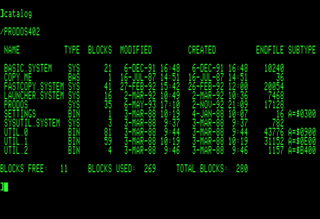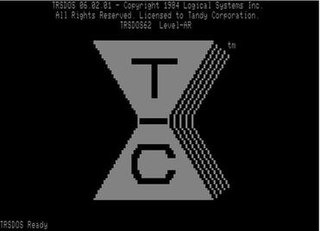Related Research Articles
AmigaDOS is the disk operating system of the AmigaOS, which includes file systems, file and directory manipulation, the command-line interface, and file redirection.

ProDOS is the name of two similar operating systems for the Apple II series of personal computers. The original ProDOS, renamed ProDOS 8 in version 1.2, is the last official operating system usable by all 8-bit Apple II series computers, and was distributed from 1983 to 1993. The other, ProDOS 16, was a stop-gap solution for the 16-bit Apple IIGS that was replaced by GS/OS within two years.
Apple DOS is the family of disk operating systems for the Apple II series of microcomputers from late 1978 through early 1983. It was superseded by ProDOS in 1983. Apple DOS has three major releases: DOS 3.1, DOS 3.2, and DOS 3.3; each one of these three releases was followed by a second, minor "bug-fix" release, but only in the case of Apple DOS 3.2 did that minor release receive its own version number, Apple DOS 3.2.1. The best-known and most-used version is Apple DOS 3.3 in the 1980 and 1983 releases. Prior to the release of Apple DOS 3.1, Apple users had to rely on audio cassette tapes for data storage and retrieval.
OS/8 is the primary operating system used on the Digital Equipment Corporation's PDP-8 minicomputer.
Commodore BASIC, also known as PET BASIC or CBM-BASIC, is the dialect of the BASIC programming language used in Commodore International's 8-bit home computer line, stretching from the PET (1977) to the Commodore 128 (1985).
KERNAL is Commodore's name for the ROM-resident operating system core in its 8-bit home computers; from the original PET of 1977, followed by the extended but related versions used in its successors: the VIC-20, Commodore 64, Plus/4, Commodore 16, and Commodore 128.

TRSDOS is the operating system for the Tandy TRS-80 line of eight-bit Zilog Z80 microcomputers that were sold through Radio Shack from 1977 through 1991. Tandy's manuals recommended that it be pronounced triss-doss. TRSDOS should not be confused with Tandy DOS, a version of MS-DOS licensed from Microsoft for Tandy's x86 line of personal computers (PCs).
fstab is a system file commonly found in the directory /etc on Unix and Unix-like computer systems. In Linux, it is part of the util-linux package. The fstab file typically lists all available disk partitions and other types of file systems and data sources that may not necessarily be disk-based, and indicates how they are to be initialized or otherwise integrated into the larger file system structure.
The Amiga Fast File System is a file system used on the Amiga personal computer. The previous Amiga filesystem was never given a specific name and known originally simply as "DOS" or AmigaDOS. Upon the release of FFS, the original filesystem became known as Amiga Old File System (OFS). OFS, which was primarily designed for use with floppy disks, had been proving slow to keep up with hard drives of the era. FFS was designed as a full replacement for the original Amiga filesystem. FFS differs from its predecessor mainly in the removal of redundant information. Data blocks contain nothing but data, allowing the filesystem to manage the transfer of large chunks of data directly from the host adapter to the final destination.

Commodore DOS, also known as CBM DOS, is the disk operating system used with Commodore's 8-bit computers. Unlike most other DOSes, which are loaded from disk into the computer's own RAM and executed there, CBM DOS is executed internally in the drive: the DOS resides in ROM chips inside the drive, and is run there by one or more dedicated MOS 6502 family CPUs. Thus, data transfer between Commodore 8-bit computers and their disk drives more closely resembles a local area network connection than typical disk/host transfers.

Atari DOS is the disk operating system used with the Atari 8-bit family of computers. Operating system extensions loaded into memory were required in order for an Atari computer to manage files stored on a disk drive. These extensions to the operating system added the disk handler and other file management features.
C*Base is a popular bulletin board system software for the Commodore 64.

The Commodore 64 home computer used various external peripherals. Due to the backwards compatibility of the Commodore 128, most peripherals would also work on that system. There is also some compatibility with the VIC-20 and Commodore PET.

A fast loader is a software program for a home computer, such as the Commodore 64 or ZX Spectrum, that accelerates the speed of file loading from floppy disk or compact cassette.
The CMD FD series was Creative Micro Designs (CMD)'s range of third-party floppy disk drives for the Commodore 8-bit line of home computers. Using 3½" floppy disks, they provided a significantly larger storage capacity than Commodore-produced drives; the FD-2000 offered 1600 kB of storage using standard double-sided, high-density floppies, while the FD-4000 also allowed the use of 3200 kB extra-high density (ED) floppies. In contrast, the Commodore 1581 3½" drive only supported 800 kB double-sided, double-density disks.
Amiga support and maintenance software performs service functions such as formatting media for a specific filesystem, diagnosing failures that occur on formatted media, data recovery after media failure, and installation of new software for the Amiga family of personal computers—as opposed to application software, which performs business, education, and recreation functions.
In Unix-like operating systems, a device file or special file is an interface to a device driver that appears in a file system as if it were an ordinary file. There are also special files in DOS, OS/2, and Windows. These special files allow an application program to interact with a device by using its device driver via standard input/output system calls. Using standard system calls simplifies many programming tasks, and leads to consistent user-space I/O mechanisms regardless of device features and functions.

SpartaDOS X is a disk operating system for the Atari 8-bit family of computers that closely resembles MS-DOS. It was developed and sold by ICD, Inc. in 1987-1993, and many years later picked up by the third-party community SpartaDOS X Upgrade Project, which still maintains the software.

AmigaOS is a family of proprietary native operating systems of the Amiga and AmigaOne personal computers. It was developed first by Commodore International and introduced with the launch of the first Amiga, the Amiga 1000, in 1985. Early versions of AmigaOS required the Motorola 68000 series of 16-bit and 32-bit microprocessors. Later versions were developed by Haage & Partner and then Hyperion Entertainment. A PowerPC microprocessor is required for the most recent release, AmigaOS 4.
References
- IDEDOS 0.91 beta http://singularcrew.hu/idedos/beta/
- IDEDOS 0.90 http://singularcrew.hu/idedos/IDE64_users_guide.pdf
- IDEDOS 0.89 http://www.volny.cz/dundera/manual.html